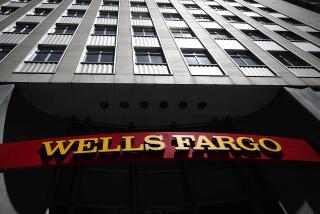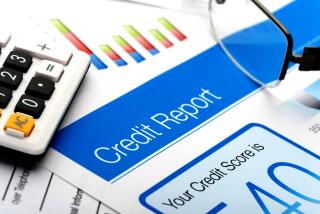Wells Fargo’s collateral damage: customers’ credit scores

A Wells Fargo Bank in Palo Alto shown on April 19, 2010. (Associated Press) The unwanted accounts created by Wells Fargo & Co. employees trying to hit aggressive sale goals have already forced the bank to provide some 100,000 customers with refunds
- Share via
The unwanted accounts created by Wells Fargo & Co. employees trying to hit aggressive sale goals have already forced the bank to provide some 100,000 customers with refunds averaging $25 for fees and other expenses.
But that may be the easy part. There also is the collateral financial damage caused by the scandal, which involved not only more than 1 million savings and checking accounts, but applications for more than 500,000 credit cards.
During a hearing Tuesday, members of the Senate Banking Committee repeatedly told Wells Fargo Chairman and Chief Executive John Stumpf that they were concerned about how unauthorized accounts could affect customers’ credit scores.
Stumpf vowed to repair the problem, and Paul Bland, executive director of the legal advocacy group Public Justice, said the San Francisco bank “should be able to resolve most of the damage,” at least in terms of identifying unwanted cards and reporting that to the credit bureaus.
But whether those steps promptly repair a customer’s tainted credit score is another matter.
Rene Holliday, 47, said he’s had three unwanted Wells Fargo revolving credit accounts on his credit reports for several years despite his requests to the bank and the major credit bureaus to delete them.
“I doubt it helped my credit score,” said Holliday, who lives in Eastvale in Riverside County and is no longer a Wells Fargo customer. “I’m not sure if it had an impact; there’s no way to find out.”
The scope of the potential credit-score problem for each customer is difficult to measure because many variables are in play with the scores, including how long a Wells Fargo customer had an unauthorized credit card and each customer’s overall credit profile, analysts said.
In some cases one unwanted credit card might not have made a substantial difference on a credit score. But any negative impact could be magnified if that tainted credit score was used to, say, determine the interest rate on a 30-year home mortgage in the hundreds of thousands of dollars, analysts said.
“Figuring out what people’s actual damages are is really, really difficult,” Bland said. “It’s going to take a lot of work and energy to unravel this.”
Goldman Sachs Group Inc.’s analysts took a stab at figuring the cost, estimating that if all the Wells Fargo customers with unwanted credit cards then applied for mortgages, they potentially faced $50 million in higher interest expenses overall.
The estimate was based on “an average 10-point reduction in a consumer’s FICO score,” Richard Ramsden and the other Goldman Sachs analysts said in a note to clients Thursday.
See the most-read stories in Business this hour »
The possibility of damage to the creditworthiness of Wells Fargo’s customers is what irked Sen. Jon Tester (D-Mont.) when he questioned Stumpf on Tuesday.
“If information was sent into the credit bureaus because of these falsely opened accounts, the impacts on this are far, far, far more than the fees or fines that could be associated with that,” Tester said. “This is a big deal.”
“Yes it is,” Stumpf replied. “We are calling each credit card customer to find out if this truly is a card that they wanted.
“If they want it, we don’t want to take away their credit,” Stumpf said. “If they did not want this, we’re going to go back and make sure that it’s made right by the credit bureau and made right by the customer. We already started that process.”
Asked to explain the process further, Wells Fargo spokeswoman Catherine Pulley said via email that “if there is an incorrect impact to a credit report, we request the incorrect information be removed.” She did not elaborate.
The three main credit bureaus -- Experian, Equifax and TransUnion -- track a consumer’s credit and the information is culled by Fair Isaac Corp. to produce a FICO score that is used by lenders to determine a borrower’s creditworthiness. The scores range from 300 to 850.
The scores reflect several factors, including the amounts owed by a borrower, their payment history, the length of their credit history and newly obtained credit (which in turn lengthens the consumer’s credit history).
Ethan Dornhelm, a principal scientist at Fair Isaac, declined to discuss the Wells Fargo situation but noted that, in general, new credit accounts for about 10% of a FICO score’s calculation.
“Generally speaking, the addition of one more credit card on to a consumer’s credit profile is not going to swing the score substantially in either direction,” Dornhelm said.
Even so, “it’s certainly possible that deleting the account could cause the score to drop” in some situations because removing the unwanted card lowers a consumer’s overall available credit, Dornhelm said.
In any case, if a borrower confirms they have an unwanted account and the credit bureaus delete it, “that will fully undue the impact that the information might have had on the FICO score,” Dornhelm said.
Unwanted credit cards could have mixed results for a customer’s credit score. On a positive note, they would show the customer has more available credit and any outstanding credit card balances they have would drop as a percentage of their total borrowing power.
But in other cases the unwanted card could cause credit-history trouble, such as if there were annual fees charged for the card that the borrower unknowingly missed or if the card was linked to one of the customer’s other Wells Fargo accounts without their knowledge.
That’s what happened to Wells Fargo customer Jerry Van Vort, who worries that his credit history was damaged by the bank’s practices.
Van Vort, 31, said he was offered a credit card last year while he was a college student in Santa Maria. He turned down the offer but received a card in the mail weeks later.
He didn’t take the time to close the account and later discovered that the bank had linked the credit card to his checking account to provide overdraft protection.
SIGN UP for the free California Inc. business newsletter »
“I didn’t have enough money in my checking account and the overdraft went onto the credit card,” said Van Vort, who now lives in upstate New York. “I had to pay that off.
“If they could reimburse people to the point where things are made fair and clean, I’d say that’s fair,” Van Vort said. “But it doesn’t seem like they’ll be able to reimburse people for all the damage.”
Chi Chi Wu, a staff attorney with the National Consumer Law Center, said Wells Fargo’s customers should not wait for the bank to fix the problem.
“The best thing is to be proactive and they should pull their credit reports, look for unauthorized items and dispute them,” Wu said. She recommended the free site www.annualcreditreport.com, as did Equifax.
“If there’s a Wells Fargo credit card account you think is unauthorized, send a dispute to the big three credit bureaus with a copy to Wells Fargo,” she said.
For more business news, follow James F. Peltz on Twitter: @PeltzLATimesTimes staff writer James Rufus Koren contributed to this report.
ALSO
Wells Fargo to pay $185 million settlement for ‘outrageous’ sales culture
Wells Fargo CEO faces bipartisan wrath during fiery Senate panel hearing
Did Wells Fargo violate overtime laws? Elizabeth Warren among 8 senators seeking Labor investigation
More to Read
Inside the business of entertainment
The Wide Shot brings you news, analysis and insights on everything from streaming wars to production — and what it all means for the future.
You may occasionally receive promotional content from the Los Angeles Times.











